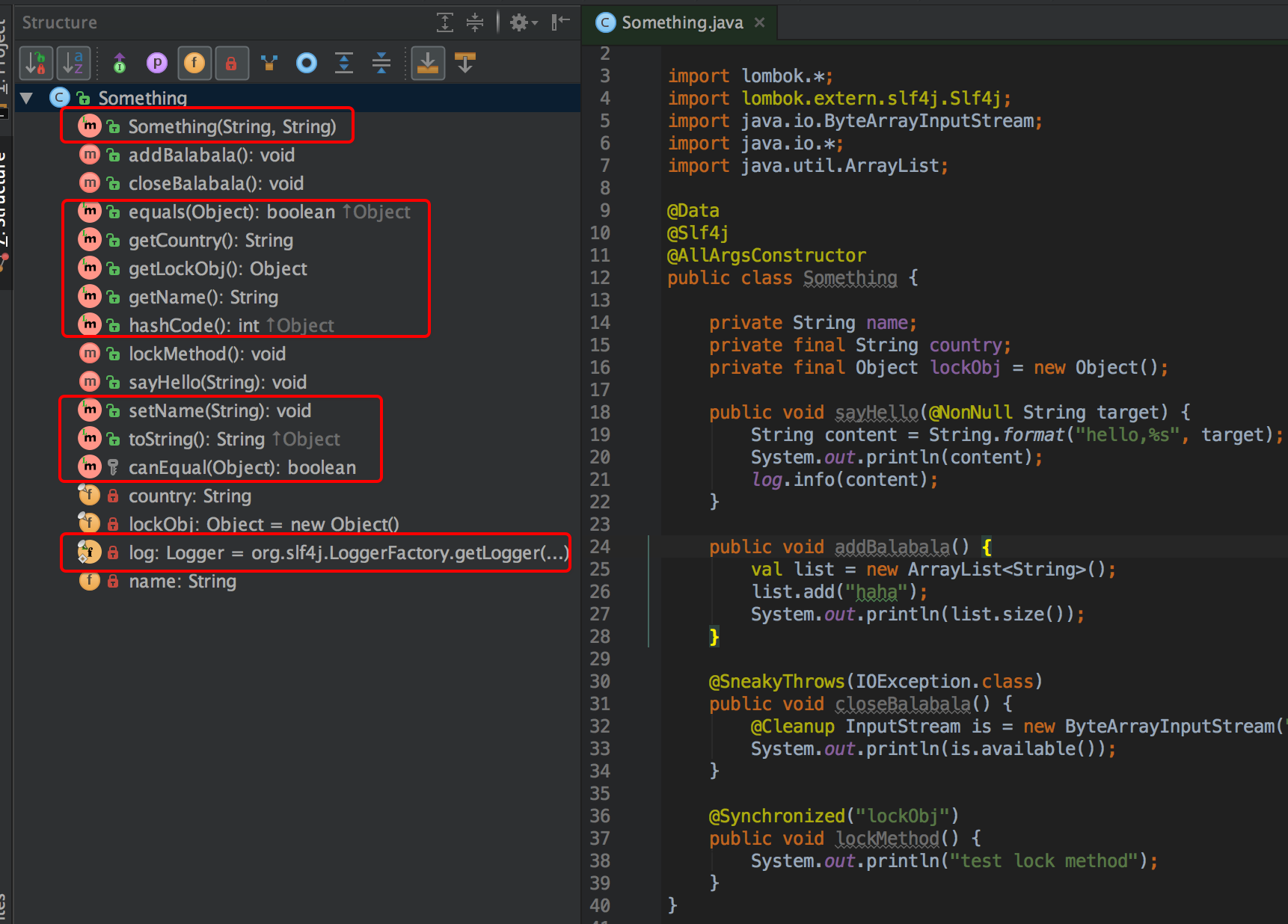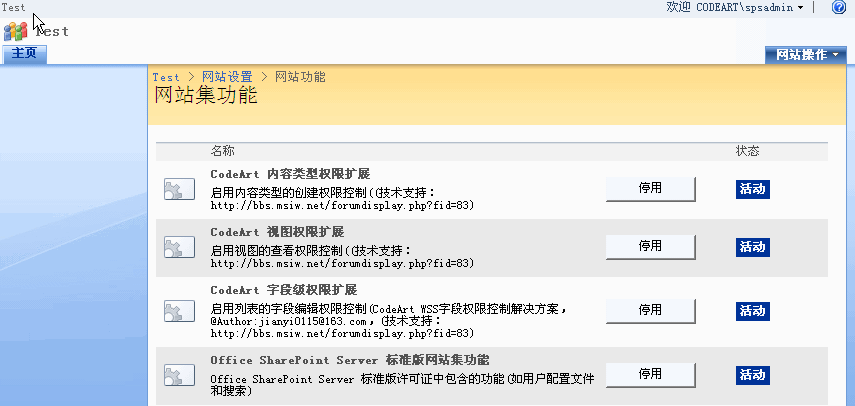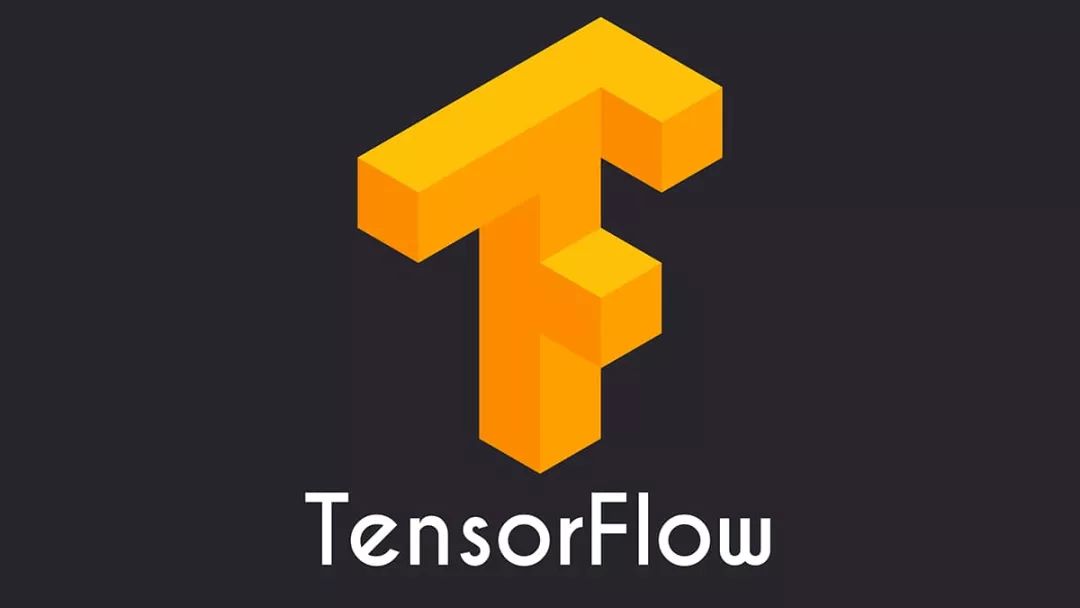转自:https://www.cnblogs.com/yjmyzz/p/lombok-with-intellij-idea.html
lombok是一款可以精减java代码、提升开发人员生产效率的辅助工具,利用注解在编译期自动生成setter/getter/toString()/constructor之类的代码。代码越少,意味着出bug的可能性越低。
官网地址:https://projectlombok.org/ 首页有一段几分钟的演示视频,看完就明白是怎么回事了。
先来二段对比代码:
这是用lombok后的java代码:
1 2 3 4 5 6 7 8 9 10 11 12 13 14 15 16 17 18 19 20 21 22 23 24 25 26 27 28 29 30 31 32 33 34 35 36 37 38 | import lombok.*;import lombok.extern.slf4j.Slf4j;import java.io.ByteArrayInputStream;import java.io.*;import java.util.ArrayList;@Data@Slf4j@AllArgsConstructorpublic class Something { private String name; private final String country; private final Object lockObj = new Object(); public void sayHello(@NonNull String target) { String content = String.format("hello,%s", target); System.out.println(content); log.info(content); } public void addBalabala() { val list = new ArrayList<String>(); list.add("haha"); System.out.println(list.size()); } @SneakyThrows(IOException.class) public void closeBalabala() { @Cleanup InputStream is = new ByteArrayInputStream("hello world".getBytes()); System.out.println(is.available()); } @Synchronized("lockObj") public void lockMethod() { System.out.println("test lock method"); }} |
等效于下面这段java代码:
1 2 3 4 5 6 7 8 9 10 11 12 13 14 15 16 17 18 19 20 21 22 23 24 25 26 27 28 29 30 31 32 33 34 35 36 37 38 39 40 41 42 43 44 45 46 47 48 49 50 51 52 53 54 55 56 57 58 59 60 61 62 63 64 65 66 67 68 69 70 71 72 73 74 75 76 77 78 79 80 81 82 83 84 85 86 87 88 89 90 91 92 93 94 95 96 97 98 99 100 101 102 103 104 105 106 107 108 109 110 111 112 113 114 115 116 117 118 119 120 121 122 123 124 125 126 127 128 129 130 131 132 133 134 135 136 137 138 139 140 141 142 143 144 145 146 147 | import java.beans.ConstructorProperties;import java.io.ByteArrayInputStream;import java.io.IOException;import java.util.ArrayList;import java.util.Collections;import lombok.NonNull;import org.slf4j.Logger;import org.slf4j.LoggerFactory;public class Something { private static final Logger log = LoggerFactory.getLogger(Something.class); private String name; private final String country; private final Object lockObj = new Object(); public void sayHello(@NonNull String target) { if(target == null) { throw new NullPointerException("target"); } else { String content = String.format("hello,%s", new Object[]{target}); System.out.println(content); log.info(content); } } public void addBalabala() { ArrayList list = new ArrayList(); list.add("haha"); System.out.println(list.size()); } public void closeBalabala() { try { ByteArrayInputStream $ex = new ByteArrayInputStream("hello world".getBytes()); try { System.out.println($ex.available()); } finally { if(Collections.singletonList($ex).get(0) != null) { $ex.close(); } } } catch (IOException var6) { throw var6; } } public void lockMethod() { Object var1 = this.lockObj; synchronized(this.lockObj) { System.out.println("test lock method"); } } public String getName() { return this.name; } public String getCountry() { return this.country; } public Object getLockObj() { return this.lockObj; } public void setName(String name) { this.name = name; } public boolean equals(Object o) { if(o == this) { return true; } else if(!(o instanceof Something)) { return false; } else { Something other = (Something)o; if(!other.canEqual(this)) { return false; } else { label47: { String this$name = this.getName(); String other$name = other.getName(); if(this$name == null) { if(other$name == null) { break label47; } } else if(this$name.equals(other$name)) { break label47; } return false; } String this$country = this.getCountry(); String other$country = other.getCountry(); if(this$country == null) { if(other$country != null) { return false; } } else if(!this$country.equals(other$country)) { return false; } Object this$lockObj = this.getLockObj(); Object other$lockObj = other.getLockObj(); if(this$lockObj == null) { if(other$lockObj != null) { return false; } } else if(!this$lockObj.equals(other$lockObj)) { return false; } return true; } } } protected boolean canEqual(Object other) { return other instanceof Something; } public int hashCode() { boolean PRIME = true; byte result = 1; String $name = this.getName(); int result1 = result * 59 + ($name == null?0:$name.hashCode()); String $country = this.getCountry(); result1 = result1 * 59 + ($country == null?0:$country.hashCode()); Object $lockObj = this.getLockObj(); result1 = result1 * 59 + ($lockObj == null?0:$lockObj.hashCode()); return result1; } public String toString() { return "Something(name=" + this.getName() + ", country=" + this.getCountry() + ", lockObj=" + this.getLockObj() + ")"; } @ConstructorProperties({"name", "country"}) public Something(String name, String country) { this.name = name; this.country = country; }} |
大概减少了2/3的代码,各种注解的详细用法,请参考:https://projectlombok.org/features/index.html

IDEA下使用时,可以通过插件的形式安装,插件下载地址:https://github.com/mplushnikov/lombok-intellij-plugin/releases
然后
Plugins -> Install plugin from disk... 选择下载的zip包安装,重启idea即可。
另外,还有一个关键设置:
为了让设置生效,建议再重启一次idea,然后就可以开心的编码了,可以ide里可以直接看到生成的方法:(下图中打红圈的都是自动生成的)

http://www.cnblogs.com/yjmyzz/p/lombok-with-intellij-idea.html
Contents
- Introduction
- Installation
- Lombok Annotations
- @Getter and @Setter
- @NonNull
- @ToString
- @EqualsAndHashCode
- @Data
- @Cleanup
- @Synchronized
- @SneakyThrows
- Costs and Benefits
- What are we missing?
- Limitations
- Controversy
- Summary
- References
Introduction
"Boilerplate" is a term used to describe code that is repeated in many parts of an application with little alteration. One of the most frequently voiced criticisms of the Java language is the volume of this type of code that is found in most projects. This problem is frequently a result of design decisions in various libraries, but is exacerbated by limitations in the language itself. Project Lombok aims to reduce the prevalence of some of the worst offenders by replacing them with a simple set of annotations.
While it is not uncommon for annotations to be used to indicate usage, to implement bindings or even to generate code used by frameworks, they are generally not used for the generation of code that is directly utilized by the application. This is partly because doing so would require that the annotations be eagerly processed at development time. Project Lombok does just that. By integrating into the IDE, Project Lombok is able to inject code that is immediately available to the developer. For example, simply adding the @Data annotation to a data class, as below, results in a number of new methods in the IDE:

Installation
Project Lombok is available as a single jar file on the project site. It includes the APIs for development as an installer for IDE integration. On most systems, simply double-clicking the jar file will launch the installer. If the system is not configured to correctly launch jar files, it can also be run from the command line as follows:
java -jar lombok.jar
The installer will attempt to detect the location of a supported IDE. If it cannot correctly determine where the IDE is installed, the location can be specified manually. Simply click "Install/Update" and IDE integration is complete. At the time of this article's writing, only Eclipse and NetBeans are supported. However, the release of the IntelliJ IDEA source code has placed IDEA support as a possibility for future releases, and limited success has already been reported with JDeveloper.

The jar file will still need to be included in the classpath of any projects that will use Project Lombok annotations. Maven users can include Lombok as a dependency by adding this to the project pom.xml file:
<dependencies><dependency><groupId>org.projectlombok</groupId><artifactId>lombok</artifactId><version>0.9.2</version></dependency> </dependencies> <repositories><repository><id>projectlombok.org</id><url>http://projectlombok.org/mavenrepo</url></repository> </repositories>
Lombok Annotations
It is not uncommon for a typical Java project to devote hundreds of lines of code to the boilerplate required for defining simple data classes. These classes generally contain a number of fields, getters and setters for those fields, as well as equals and hashCode implementations. In the simplest scenarios, Project Lombok can reduce these classes to the required fields and a single @Data annotation.
Of course, the simplest scenarios are not necessarily the ones that developers face on a day-to-day basis. For that reason, there are a number of annotations in Project Lombok to allow for more fine grained control over the structure and behavior of a class.
@Getter and @Setter
The @Getter and @Setter annotations generate a getter and setter for a field, respectively. The getters generated correctly follow convention for boolean properties, resulting in an isFoo getter method name instead of getFoofor any boolean field foo. It should be noted that if the class to which the annotated field belongs contains a method of the same name as the getter or setter to be generated, regardless of parameter or return types, no corresponding method will be generated.
Both the @Getter and @Setter annotations take an optional parameter to specify the access level for the generated method.
Lombok annotated code:
@Getter @Setter private boolean employed = true; @Setter(AccessLevel.PROTECTED) private String name;
Equivalent Java source code:
private boolean employed = true;
private String name;public boolean isEmployed() {return employed;
}public void setEmployed(final boolean employed) {this.employed = employed;
}protected void setName(final String name) {this.name = name;
}@NonNull
The @NonNull annotation is used to indicate the need for a fast-fail null check on the corresponding member. When placed on a field for which Lombok is generating a setter method, a null check will be generated that will result in a NullPointerException should a null value be provided. Additionally, if Lombok is generating a constructor for the owning class then the field will be added to the constructor signature and the null check will be included in the generated constructor code.
This annotation mirrors @NotNull and @NonNull annotations found in IntelliJ IDEA and FindBugs, among others. Lombok is annotation agnostic with regards to these variations on the theme. If Lombok comes across any member annotated with any annotation of the name @NotNull or @NonNull, it will honor it by generating the appropriate corresponding code. The authors of Project Lombok further comment that, in the event that annotation of this type is added to Java, then the Lombok version will be subject to removal.
Lombok annotated code from the class Family:
@Getter @Setter @NonNull private List<Person> members;
Equivalent Java source code:
@NonNull
private List<Person> members;public Family(@NonNull final List<Person> members) {if (members == null) throw new java.lang.NullPointerException("members");this.members = members;
}@NonNull
public List<Person> getMembers() {return members;
}public void setMembers(@NonNull final List<Person> members) {if (members == null) throw new java.lang.NullPointerException("members");this.members = members;
}@ToString
This annotation generates an implementation of the toString method. By default, any non-static fields will be included in the output of the method in name-value pairs. If desired, the inclusion of the property names in the output can be suppressed by setting the annotation parameter includeFieldNames to false.
Specific fields can be excluded from the output of the generated method by including their field names in the exclude parameter. Alternatively, the of parameter can be used to list only those fields which are desired in the output. The output of the toString method of a superclass can also be included by setting the callSuper parameter to true.
Lombok annotated code:
@ToString(callSuper=true,exclude="someExcludedField")
public class Foo extends Bar {private boolean someBoolean = true;private String someStringField;private float someExcludedField;
}Equivalent Java source code:
public class Foo extends Bar {private boolean someBoolean = true;private String someStringField;private float someExcludedField;@java.lang.Overridepublic java.lang.String toString() {return "Foo(super=" + super.toString() +", someBoolean=" + someBoolean +", someStringField=" + someStringField + ")";}
}@EqualsAndHashCode
This class level annotation will cause Lombok to generate both equals and hashCode methods, as the two are tied together intrinsically by the hashCode contract. By default, any field in the class that is not static or transient will be considered by both methods. Much like @ToString, the exclude parameter is provided to prevent field from being included in the generated logic. One can also use the of parameter to list only those fields should be considered.
Also like @ToString, there is a callSuper parameter for this annotation. Setting it to true will cause equals to verify equality by calling the equals from the superclass before considering fields in the current class. For thehashCode method, it results in the incorporation of the results of the superclass's hashCode in the calculation of the hash. When setting callSuper to true, be careful to make sure that the equals method in the parent class properly handles instance type checking. If the parent class checks that the class is of a specific type and not merely that the classes of the two objects are the same, this can result in undesired results. If the superclass is using a Lombok generated equals method, this is not an issue. However, other implementations may not handle this situation correctly. Also note that setting callSuper to true cannot be done when the class only extends Object, as it would result in an instance equality check that short-circuits the comparison of fields. This is due to the generated method calling the equals implementation on Object, which returns false if the two instances being compared are not the same instance. As a result, Lombok will generate a compile time error in this situation.
Lombok annotated code:
@EqualsAndHashCode(callSuper=true,exclude={"address","city","state","zip"})
public class Person extends SentientBeing {enum Gender { Male, Female }@NonNull private String name;@NonNull private Gender gender;private String ssn;private String address;private String city;private String state;private String zip;
}Equivalent Java source code:
public class Person extends SentientBeing {enum Gender {/*public static final*/ Male /* = new Gender() */,/*public static final*/ Female /* = new Gender() */;}@NonNullprivate String name;@NonNullprivate Gender gender;private String ssn;private String address;private String city;private String state;private String zip;@java.lang.Overridepublic boolean equals(final java.lang.Object o) {if (o == this) return true;if (o == null) return false;if (o.getClass() != this.getClass()) return false;if (!super.equals(o)) return false;final Person other = (Person)o;if (this.name == null ? other.name != null : !this.name.equals(other.name)) return false;if (this.gender == null ? other.gender != null : !this.gender.equals(other.gender)) return false;if (this.ssn == null ? other.ssn != null : !this.ssn.equals(other.ssn)) return false;return true;}@java.lang.Overridepublic int hashCode() {final int PRIME = 31;int result = 1;result = result * PRIME + super.hashCode();result = result * PRIME + (this.name == null ? 0 : this.name.hashCode());result = result * PRIME + (this.gender == null ? 0 : this.gender.hashCode());result = result * PRIME + (this.ssn == null ? 0 : this.ssn.hashCode());return result;}
}@Data
The @Data annotation is likely the most frequently used annotation in the Project Lombok toolset. It combines the functionality of @ToString, @EqualsAndHashCode, @Getter and @Setter. Essentially, using @Data on a class is the same as annotating the class with a default @ToString and @EqualsAndHashCode as well as annotating each field with both @Getter and @Setter. Annotation a class with @Data also triggers Lombok's constructor generation. This adds a public constructor that takes any @NonNull or final fields as parameters. This provides everything needed for a Plain Old Java Object (POJO).
While @Data is extremely useful, it does not provide the same granularity of control as the other Lombok annotations. In order to override the default method generation behaviors, annotate the class, field or method with one of the other Lombok annotations and specify the necessary parameter values to achieve the desired effect.
@Data does provide a single parameter option that can be used to generate a static factory method. Setting the value of the staticConstructor parameter to the desired method name will cause Lombok to make the generated constructor private and expose a a static factory method of the given name.
Lombok annotated code:
@Data(staticConstructor="of")
public class Company {private final Person founder;private String name;private List<Person> employees;
}Equivalent Java source code:
public class Company {private final Person founder;private String name;private List<Person> employees;private Company(final Person founder) {this.founder = founder;}public static Company of(final Person founder) {return new Company(founder);}public Person getFounder() {return founder;}public String getName() {return name;}public void setName(final String name) {this.name = name;}public List<Person> getEmployees() {return employees;}public void setEmployees(final List<Person> employees) {this.employees = employees;}@java.lang.Overridepublic boolean equals(final java.lang.Object o) {if (o == this) return true;if (o == null) return false;if (o.getClass() != this.getClass()) return false;final Company other = (Company)o;if (this.founder == null ? other.founder != null : !this.founder.equals(other.founder)) return false;if (this.name == null ? other.name != null : !this.name.equals(other.name)) return false;if (this.employees == null ? other.employees != null : !this.employees.equals(other.employees)) return false;return true;}@java.lang.Overridepublic int hashCode() {final int PRIME = 31;int result = 1;result = result * PRIME + (this.founder == null ? 0 : this.founder.hashCode());result = result * PRIME + (this.name == null ? 0 : this.name.hashCode());result = result * PRIME + (this.employees == null ? 0 : this.employees.hashCode());return result;}@java.lang.Overridepublic java.lang.String toString() {return "Company(founder=" + founder + ", name=" + name + ", employees=" + employees + ")";}
}@Cleanup
The @Cleanup annotation can be used to ensure that allocated resources are released. When a local variable is annotated with @Cleanup, any subsequent code is wrapped in a try/finally block that guarantees that the cleanup method is called at the end of the current scope. By default @Cleanup assumes that the cleanup method is named "close", as with input and output streams. However, a different method name can be provided to the annotation'svalue parameter. Only cleanup methods which take no parameters are able to be used with this annotation.
There is also a caveat to consider when using the @Cleanup annotation. In the event that an exception is thrown by the cleanup method, it will preempt any exception that was thrown in the method body. This can result in the actual cause of an issue being buried and should be considered when choosing to use Project Lombok's resource management. Furthermore, with automatic resource management on the horizon in Java 7, this particular annotation is likely to be relatively short-lived.
Lombok annotated code:
public void testCleanUp() {try {@Cleanup ByteArrayOutputStream baos = new ByteArrayOutputStream();baos.write(new byte[] {'Y','e','s'});System.out.println(baos.toString());} catch (IOException e) {e.printStackTrace();}
}Equivalent Java source code:
public void testCleanUp() {try {ByteArrayOutputStream baos = new ByteArrayOutputStream();try {baos.write(new byte[]{'Y', 'e', 's'});System.out.println(baos.toString());} finally {baos.close();}} catch (IOException e) {e.printStackTrace();}
}@Synchronized
Using the synchronized keyword on a method can result in unfortunate effects, as any developer who has worked on multi-threaded software can attest. The synchronized keyword will lock on the current object (this) in the case of an instance method or on the class object for a static method. This means that there is the potential for code outside of the control of the developer to lock on the same object, resulting in a deadlock. It is generally advisable to instead lock explicitly on a separate object that is dedicated solely to that purpose and not exposed in such a way as to allow unsolicited locking. Project Lombok provides the @Synchronized annotation for that very purpose.
Annotating an instance method with @Synchronized will prompt Lombok to generate a private locking field named $lock on which the method will lock prior to executing. Similarly, annotating a static method in the same way will generate a private static object named $LOCK for the static method to use in an identical fashion. A different locking object can be specified by providing a field name to the annotation's value parameter. When a field name is provided, the developer must define the property as Lombok will not generate it.
Lombok annotated code:
private DateFormat format = new SimpleDateFormat("MM-dd-YYYY");@Synchronized
public String synchronizedFormat(Date date) {return format.format(date);
}Equivalent Java source code:
private final java.lang.Object $lock = new java.lang.Object[0];
private DateFormat format = new SimpleDateFormat("MM-dd-YYYY");public String synchronizedFormat(Date date) {synchronized ($lock) {return format.format(date);}
}@SneakyThrows
@SneakyThrows is probably the Project Lombok annotation with the most detractors, since it is a direct assault on checked exceptions. There is a lot of disagreement with regards to the use of checked exceptions, with a large number of developers holding that they are a failed experiment. These developers will love @SneakyThrows. Those developers on the other side of the checked/unchecked exception fence will most likely view this as hiding potential problems.
Throwing IllegalAccessException would normally generate an "Unhandled exception" error if IllegalAccessException, or some parent class, is not listed in a throws clause:

When annotated with @SneakyThrows, the error goes away.

By default, @SneakyThrows will allow any checked exception to be thrown without declaring in the throws clause. This can be limited to a particular set of exceptions by providing an array of throwable classes ( Class<? extends Throwable>) to the value parameter of the annotation.
Lombok annotated code:
@SneakyThrows
public void testSneakyThrows() {throw new IllegalAccessException();
}Equivalent Java source code:
public void testSneakyThrows() {try {throw new IllegalAccessException();} catch (java.lang.Throwable $ex) {throw lombok.Lombok.sneakyThrow($ex);}
}A look at the above code and the signature of Lombok.sneakyThrow(Throwable) would lead most to believe that the exception is being wrapped in a RuntimeException and re-thrown, however this is not the case. ThesneakyThrow method will never return normally and will instead throw the provided throwable completely unaltered.
Costs and Benefits
As with any technology choice, there are both positive and negative effects of using Project Lombok. Incorporating Lombok's annotations in a project can greatly reduce the number of lines of boilerplate code that are either generated in the IDE or written by hand. This results in reduced maintenance overhead, fewer bugs and more readable classes.
That is not to say that there are not downsides to using Project Lombok annotations in your project. Project Lombok is largely aimed at filling gaps in the Java language. As such, there is the possibility that changes to the language will take place that preclude the use of Lombok's annotations, such as the addition of first class property support. Additionally, when used in combination with annotation-based object-relational mapping (ORM) frameworks, the number of annotations on data classes can begin to get unwieldy. This is largely offset by the amount of code that is superseded by the Lombok annotations. However, those who shun the frequent use of annotations may choose to look the other way.
What is missing?
Project Lombok provides the delombok utility for replacing the Lombok annotations with equivalent source code. This can be done for an entire source directory via the command line.
java -jar lombok.jar delombok src -d src-delomboked
Alternatively, an Ant task is provided for incorporation into a build process.
<target name="delombok"><taskdef classname="lombok.delombok.ant.DelombokTask"classpath="WebRoot/WEB-INF/lib/lombok.jar" name="delombok" /><mkdir dir="src-delomboked" /><delombok verbose="true" encoding="UTF-8" to="src-delomboked"from="src" /> </target>
Both delombok and the corresponding Ant task come packaged in the core lombok.jar download. Along with allowing Lombok annotations to be useful in applications built using Google Web Toolkit (GWT) or other incompatible frameworks, running delombok on the Person class makes it easy to contrast the class as written using the Lombok annotations against code that includes the equivalent boilerplate inline.
package com.ociweb.jnb.lombok;import java.util.Date;import lombok.Data;
import lombok.EqualsAndHashCode;
import lombok.NonNull;@Data
@EqualsAndHashCode(exclude={"address","city","state","zip"})
public class Person {enum Gender { Male, Female }@NonNull private String firstName;@NonNull private String lastName;@NonNull private final Gender gender;@NonNull private final Date dateOfBirth;private String ssn;private String address;private String city;private String state;private String zip;
}The code utilizing the Project Lombok annotations is significantly more concise than the equivalent class with the boilerplate included.
package com.ociweb.jnb.lombok;import java.util.Date;
import lombok.NonNull;public class Person {enum Gender {/*public static final*/ Male /* = new Gender() */,/*public static final*/ Female /* = new Gender() */;}@NonNullprivate String firstName;@NonNullprivate String lastName;@NonNullprivate final Gender gender;@NonNullprivate final Date dateOfBirth;private String ssn;private String address;private String city;private String state;private String zip;public Person(@NonNull final String firstName, @NonNull final String lastName,@NonNull final Gender gender, @NonNull final Date dateOfBirth) {if (firstName == null)throw new java.lang.NullPointerException("firstName");if (lastName == null)throw new java.lang.NullPointerException("lastName");if (gender == null)throw new java.lang.NullPointerException("gender");if (dateOfBirth == null)throw new java.lang.NullPointerException("dateOfBirth");this.firstName = firstName;this.lastName = lastName;this.gender = gender;this.dateOfBirth = dateOfBirth;}@NonNullpublic String getFirstName() {return firstName;}public void setFirstName(@NonNull final String firstName) {if (firstName == null)throw new java.lang.NullPointerException("firstName");this.firstName = firstName;}@NonNullpublic String getLastName() {return lastName;}public void setLastName(@NonNull final String lastName) {if (lastName == null)throw new java.lang.NullPointerException("lastName");this.lastName = lastName;}@NonNullpublic Gender getGender() {return gender;}@NonNullpublic Date getDateOfBirth() {return dateOfBirth;}public String getSsn() {return ssn;}public void setSsn(final String ssn) {this.ssn = ssn;}public String getAddress() {return address;}public void setAddress(final String address) {this.address = address;}public String getCity() {return city;}public void setCity(final String city) {this.city = city;}public String getState() {return state;}public void setState(final String state) {this.state = state;}public String getZip() {return zip;}public void setZip(final String zip) {this.zip = zip;}@java.lang.Overridepublic java.lang.String toString() {return "Person(firstName=" + firstName + ", lastName=" + lastName + ", gender=" + gender + ", dateOfBirth=" + dateOfBirth +", ssn=" + ssn + ", address=" + address + ", city=" + city +", state=" + state + ", zip=" + zip + ")";}@java.lang.Overridepublic boolean equals(final java.lang.Object o) {if (o == this) return true;if (o == null) return false;if (o.getClass() != this.getClass()) return false;final Person other = (Person)o;if (this.firstName == null? other.firstName != null: !this.firstName.equals(other.firstName))return false;if (this.lastName == null? other.lastName != null: !this.lastName.equals(other.lastName))return false;if (this.gender == null? other.gender != null: !this.gender.equals(other.gender))return false;if (this.dateOfBirth == null? other.dateOfBirth != null: !this.dateOfBirth.equals(other.dateOfBirth))return false;if (this.ssn == null? other.ssn != null: !this.ssn.equals(other.ssn))return false;return true;}@java.lang.Overridepublic int hashCode() {final int PRIME = 31;int result = 1;result = result * PRIME +(this.firstName == null ? 0 : this.firstName.hashCode());result = result * PRIME +(this.lastName == null ? 0 : this.lastName.hashCode());result = result * PRIME +(this.gender == null ? 0 : this.gender.hashCode());result = result * PRIME +(this.dateOfBirth == null ? 0 : this.dateOfBirth.hashCode());result = result * PRIME +(this.ssn == null ? 0 : this.ssn.hashCode());return result;}
}Keep in mind that this is not just code that normally has to be written, but must also be read by maintaining developers. This means that, when using the annotations provided by Project Lombok, developers do not have to wade through countless lines of code in order to determine if the class in question is a simple data class or something more sinister.
Limitations
While Project Lombok does some dramatic things to make a developer's life easier, it has its limitations. Browsing the issues list will quickly illuminate some of the current shortcomings, most of which are minor. One important problem is the inability to detect the constructors of a superclass. This means that if a superclass has no default constructor any subclasses cannot use the @Data annotation without explicitly writing a constructor to make use of the available superclass constructor. Since Project Lombok respects any methods that match the name of a method to be generated, the majority of its feature shortcomings can be overcome using this approach.
Controversy
A number of issues have been raised against the use of Project Lombok. The most common argument holds that annotations were intended for "meta" information and are not to be used in such a way that would leave the codebase unable to be compiled were they removed. This is certainly the situation with Lombok annotations. New methods result from these annotations that are intended to be used not only by a framework, but by other parts of the application. Project Lombok's development-time support is its bread and butter, but this does have consequences, not the least of which is limited IDE support.
As previously stated, @SneakyThrows is bound to stir up the age-old argument over checked and unchecked exceptions. Opinions on this debate are often almost religious in their ferocity. As such, the arguments against the use of @SneakyThrows are also sure to excite fervor among the passionate.
Another point of contention is the implementation of both the code supporting IDE integration as well as the javac annotation processor. Both of these pieces of Project Lombok make use of non-public APIs to accomplish their sorcery. This means that there is a risk that Project Lombok will be broken with subsequent IDE or JDK releases. Here is how one of the project founders, Reinier Zwitserloot described the situation:
It's a total hack. Using non-public API. Presumptuous casting (knowing that an annotation processor running in javac will get an instance of JavacAnnotationProcessor, which is the internal implementation of AnnotationProcessor (an interface), which so happens to have a couple of extra methods that are used to get at the live AST).On eclipse, it's arguably worse (and yet more robust) - a java agent is used to inject code into the eclipse grammar and parser class, which is of course entirely non-public API and totally off limits.If you could do what lombok does with standard API, I would have done it that way, but you can't. Still, for what its worth, I developed the eclipse plugin for eclipse v3.5 running on java 1.6, and without making any changes it worked on eclipse v3.4 running on java 1.5 as well, so it's not completely fragile.
Summary
Project Lombok is a powerful tool for the pragmatic developer. It provides a set of useful annotations for eliminating a tremendous amount of boilerplate code from your Java classes. In the best cases, a mere five characters can replace hundreds of lines of code. The result is Java classes that are clean, concise and easy to maintain. These benefits do come with a cost however. Using Project Lombok in an IntelliJ IDEA shop is simply not yet a viable option. There is a risk of breakage with IDE and JDK upgrades as well as controversy surrounding the goals and implementation of the project. What all this translates to is no different than what must be considered for any technology choice. There are always gains to be made and losses to be had. The question is simply whether or not Project Lombok can provide more value than cost for the project at hand. If nothing else, Project Lombok is sure to inject some new life into the discussion of language features that have withered on the vine thus far and that is a win from any perspective.
References
- Project Lombok -
http://projectlombok.org - Lombok API Documentation -
http://projectlombok.org/api/index.html - Project Lombok Issues List -
http://code.google.com/p/projectlombok/issues/list - Use Lombok via Maven -
http://projectlombok.org/mavenrepo/index.html - Project Lombok Google Group -
http://groups.google.com/group/project-lombok - Reviewing Project Lombok or the Right Way to Write a Library -
http://www.cforcoding.com/2009/11/reviewing-project-lombok-or-right-way.html - Morbok: Extensions for Lombok -
http://code.google.com/p/morbok - Using Project Lombok with JDeveloper -
http://kingsfleet.blogspot.com/2009/09/project-lombok-interesting-bean.html - Example Code -
LombokExample.zip
Thanks to Mark Volkmann, Eric Burke, Mario Aquino and Lance Finney for reviewing and providing suggestions for this article, and a special thanks to Mark Volkmann for introducing me to Project Lombok.
http://jnb.ociweb.com/jnb/jnbJan2010.html

















